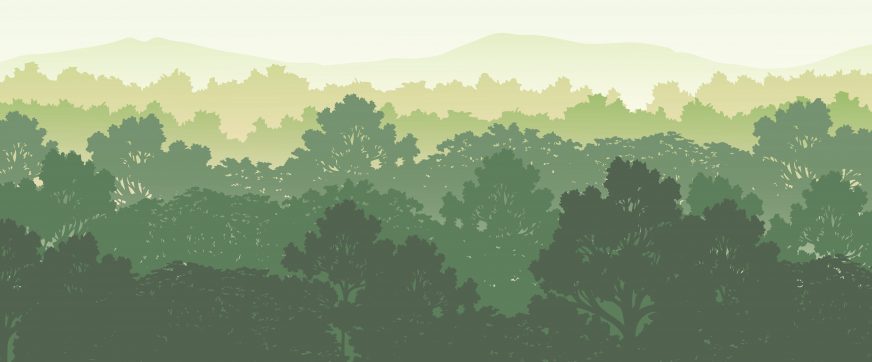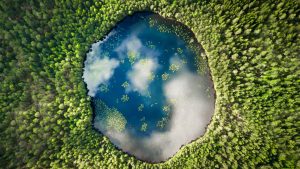- SIWI – Leading expert in water governance
- /
- Latest
- /
- Are forests crucial to reaching our climate targets?
Are forests crucial to reaching our climate targets?

More and more hopes are pinned to nature-based solutions to tackle both the climate crisis and the rapid degradation of nature. Research indicates that this type of solutions could contribute one-third of the climate mitigation needed to keep global warming below 2 degrees Celsius. Nature should therefore play a key role in climate discussions, such as the Leaders’ Summit on Climate on 22-23 April, and the COP26 UN climate summit in November.
But to what extent are nature-based solutions really being rolled out and how successful are they? That was discussed at the event Are Forests Crucial to Reaching our Climate Targets?, organized on 19 April by the Forest-Water Champions Network and moderated by Ingrid Timboe from AGWA. The Forest-Water Champions Network is an expert network founded by SIWI together with the Food and Agriculture Organization of the United Nations (FAO) and the International Union for Conservation of Nature (IUCN).
Lessons learned
Catherine Martini from the NDC Partnership noted that it is indeed becoming very common for countries to include nature-based solutions in their nationally determined contributions, NDCs, to the Paris Agreement. In the first round of NDC reporting, 130 out of 196 countries mentioned nature-based solutions. However, these references are not always very detailed, and Catherine Martini argued that countries must do more to scope out how these solutions will be implemented: “The challenge remains, how can nature-based solutions be included in country plans that are detailed and measurable,” she said.
An interesting example from Rwanda shows how nature-based solutions can offer many benefits simultaneously. Musana Segatagara Bernard, Head of Knowledge and Forecasting Rwanda Water Resources Board, described the innovative approach where investments in catchment restoration, agroforestry and tree plantations help protect watersheds. This can both reduce soil erosion and increase the efficiency of hydropower, contributing to mitigation and adaptation strategies related to climate change.
Success in Latin America
Latin America was early in seeing the potential of nature-based solutions and they are now rapidly gaining traction. Kirstie Lopez, NBS Technical Expert at the Ministry of Environment and Sustainable Development, shared experiences from Colombia, where 148 nature-based solutions will play a key role when the country aims to rapidly slash greenhouse gas emissions.
In Peru, 2017 was a decisive year. After disastrous floods and landslides killed 138 people and made 700,000 homeless, the government decided to invest 7 billion USD in a building back programme where 1.5 billion was allocated to strengthening the resilience of affected watersheds. The aim was to repair defences and infrastructure, improve flood control and invest in early-alert systems.
That successful programme is now expected to be followed by a 242 million USD investment in nature-based solutions to reduce water and climate risks. Through reforestation of 45,000 hectares of land, it is expected that more than 8,000 full-time job equivalents will be created over four years while over 3,000 tonnes of CO2 equivalents can be sequestered.
“I think this is an extraordinary story of actually scaling and accelerating investments in nature-based solutions,” commented Gena Gammie from Forest Trends who is heavily involved in the Peruvian programme. But she also talked about lessons to be learned. A key message was that there must be a robust pipeline that really considers how these programmesare being rolled out every step of the way, including monitoring and evaluation. Both international cooperation and civil society can play an important role in supporting this. She also stressed that policies must allow for many different types of nature-based solutions for different contexts.
The role of finance
“Flexibility” is also the motto when natural capital and biodiversity are now rapidly being streamlined into all the activities of the Inter-American Development Bank (IDB), according to Gregory Watson, Lead Specialist at the Bank’s Natural Capital Lab. “A key part of that, obviously, is nature-based solutions, identifying in the country the intersection between NDC priorities, biodiversity strategy and action plans, Covid-recovery strategies, and infrastructure plans, to find these win-win-win projects where one dollar can have multiple impacts,” he explained.
To succeed, Gregory Watson stressed the importance of not just working with ministries of the environment but of also speaking to the Ministry of Finance and the private sector. “You need to meet them where they are and come to them with the arguments that speak to their objectives and maybe not lead with the nature-first agenda. It’s more ´Let me show you what nature can do for you´,” Watson said.
IDB is currently doing this in 15 countries. At the same time, the bank is also analyzing the obstacles to successful implementation of nature-based solutions. According to this research, budget processes, sectoral planning, procurement criteria and construction codes are often designed in a way that create barriers. To overcome these, the bank sees a need for more performance metrics and proof of concepts, ongoing performance monitoring, and funding for monitoring and evaluation.
Drawing conclusions from the seminar, James Dalton, from the IUCN and the Forest-Water Champions, saw great potential. There is currently a lot happening and dedicated people can now act as brokers between different sectors like forestry, water, and engineering. “That helps us attract and scale finance, so I am very optimistic about the possibilities there and see some great success stories already from across the countries and from the partnerships that have been presented,” he said.
Most recent

SIWI’s endorsement of the COP29 Declaration on Water for Climate Action
- Water and climate
- World Water Week
- Water governance

SIWI-WASH experts join IVL
- Water, Sanitation and Hygiene (WASH)
- Water governance

Women hold the key to building climate resilience
- Gender and water
- Resilience through water

Water for Climate in Baku

Join us on a journey through 2023

The world can’t afford a water dry Summit of the Future



